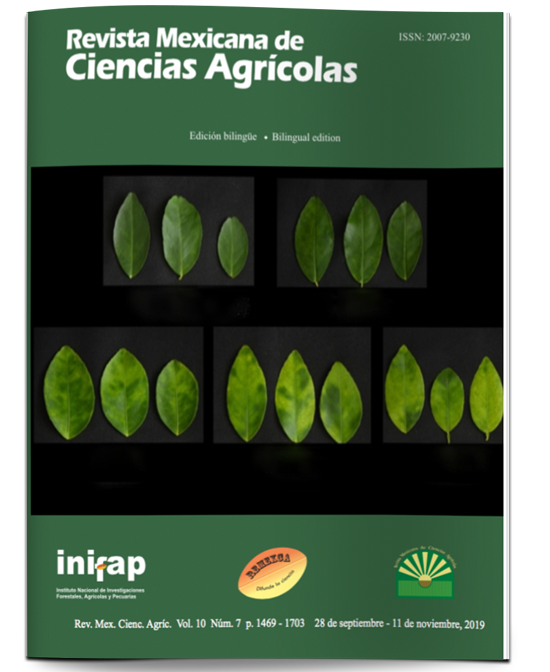Physiological changes in Mexican lemon trees in production infected with HLB
DOI:
https://doi.org/10.29312/remexca.v10i7.1957Keywords:
Citrus aurantifolia, chlorophyll, huanglongbing, sugarsAbstract
Huanglongbing (HLB) is the most devastating citrus disease in the world and has been present in the state of Colima since 2010, the area producing Mexican lemon (Citrus aurantifolia). This disease causes an imbalance in the distribution of carbohydrates and inhibits photosynthesis. It also affects the concentration of nutrients in leaf. The objective of this work was to determine the physiological changes in trees in Mexican lemon production infected with HLB. The study was carried out in Colima in 2017. The concentration of starch, sucrose and glucose was determined in the central leaf veins and sheet of leaves of different ages (120 and 30 days) and root starch. The concentration of chlorophylls by analytical method and SPAD index in leaves with different levels of HLB symptoms and foliar analysis of mineral nutrients. The leaves with HLB had a higher concentration of starch in the 120-day leaf. Sucrose was concentrated in the leaf veins of 120 days. While glucose was increased in the leaf veins of 30 and 120 days. The roots of trees infected with HLB showed 40% lower concentration of starch compared to healthy trees. Decrease in chlorophyll content and SPAD index depending on the degree of involvement. As well as lower concentration of K, Ca, Mg, Cu, Fe, Zn and B. Knowing the changes caused by HLB in Mexican lemon will allow to develop practices that reduce its impact.
Downloads
Published
How to Cite
Issue
Section
License
The authors who publish in Revista Mexicana de Ciencias Agrícolas accept the following conditions:
In accordance with copyright laws, Revista Mexicana de Ciencias Agrícolas recognizes and respects the authors’ moral right and ownership of property rights which will be transferred to the journal for dissemination in open access. Invariably, all the authors have to sign a letter of transfer of property rights and of originality of the article to Instituto Nacional de Investigaciones Forestales, Agrícolas y Pecuarias (INIFAP) [National Institute of Forestry, Agricultural and Livestock Research]. The author(s) must pay a fee for the reception of articles before proceeding to editorial review.
All the texts published by Revista Mexicana de Ciencias Agrícolas —with no exception— are distributed under a Creative Commons License Attribution-NonCommercial 4.0 International (CC BY-NC 4.0), which allows third parties to use the publication as long as the work’s authorship and its first publication in this journal are mentioned.
The author(s) can enter into independent and additional contractual agreements for the nonexclusive distribution of the version of the article published in Revista Mexicana de Ciencias Agrícolas (for example include it into an institutional repository or publish it in a book) as long as it is clearly and explicitly indicated that the work was published for the first time in Revista Mexicana de Ciencias Agrícolas.
For all the above, the authors shall send the Letter-transfer of Property Rights for the first publication duly filled in and signed by the author(s). This form must be sent as a PDF file to: revista_atm@yahoo.com.mx; cienciasagricola@inifap.gob.mx; remexca2017@gmail.
This work is licensed under a Creative Commons Attribution-Noncommercial 4.0 International license.



